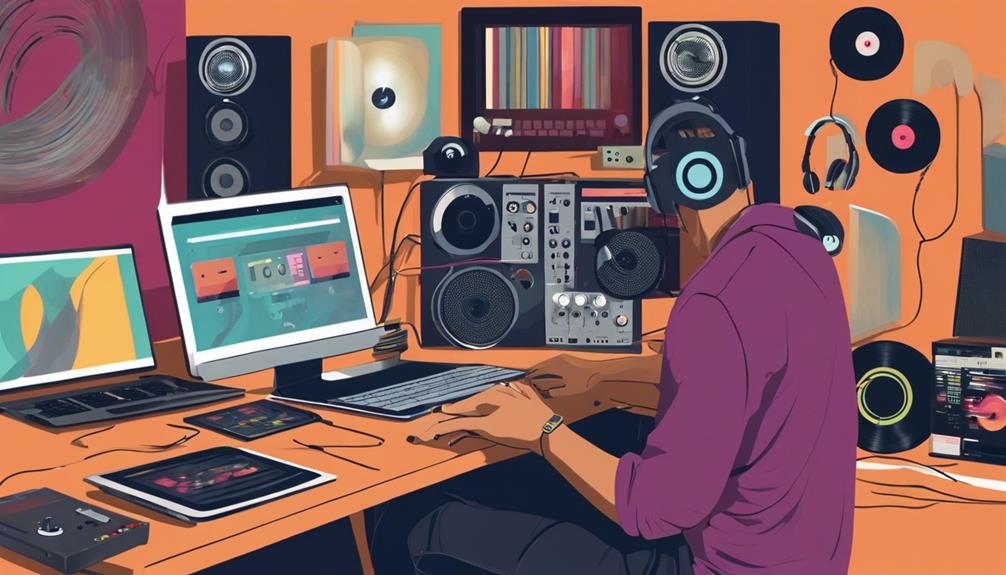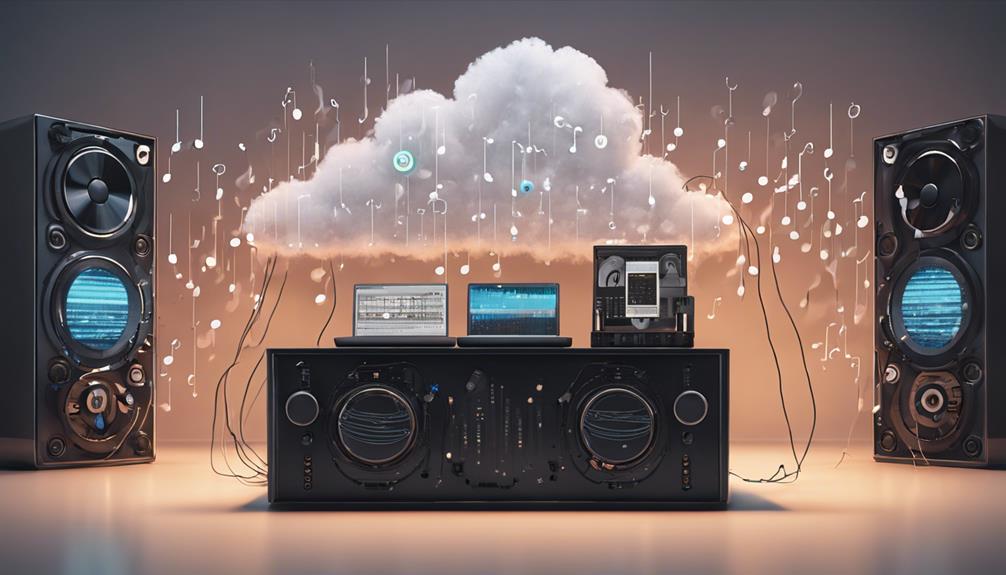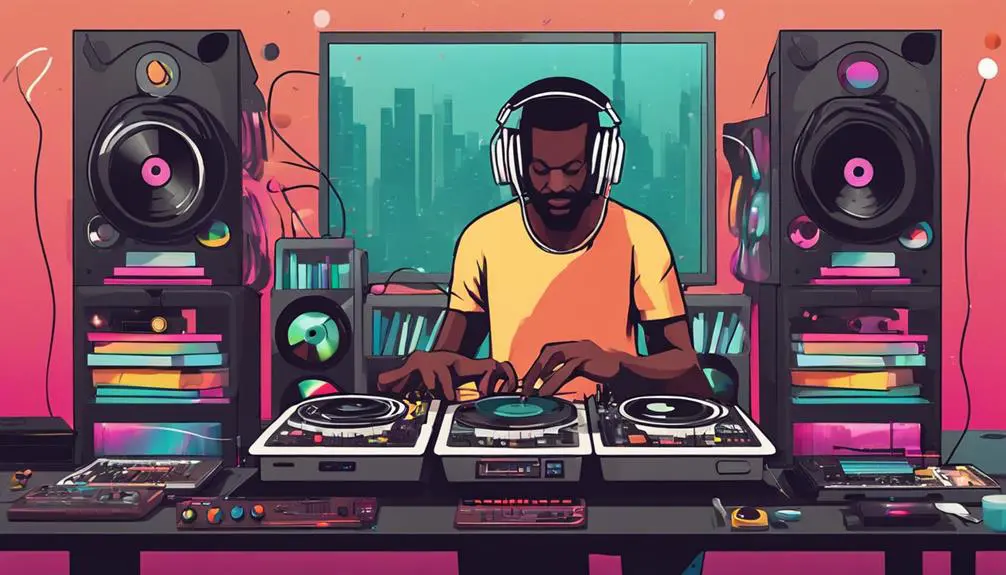Subtotal: £30.00
To efficiently organize your DJ library, start by creating clear genre folders, sorting sub-genres within these. Use crates and playlists to further categorize tracks by mood or event, customizing each to suit different vibes. Implement thorough tagging for each track, including genre, BPM, and key; this helps instantly access specific types of music. Regularly update your library, adding fresh tracks and removing outdated ones to keep your sets relevant. Additionally, review and adjust your categories to better align with shifting music trends and audience tastes. Mastering these tips will sharpen your sets, encouraging broader musical exploration.
Key Takeaways
- Create main genre folders and subfolders for precise music categorization.
- Use descriptive tags for genre, BPM, key, and mood on every track.
- Regularly update your library to include new tracks and remove outdated ones.
- Curate playlists and crates by mood, energy level, and event type.
- Analyze and adjust genre categories based on audience feedback and trends.
Establish Clear Genre Folders
To efficiently manage your DJ library, start by creating main genre folders that house various music styles. This folder hierarchy is essential for quick access and seamless DJ set preparation.
Within each main genre folder, dive deeper by organizing sub-genres. For instance, under a ‘House’ folder, you might’ve sub-folders like ‘Deep House,’ ‘Tech House,’ or ‘Progressive House.’ This sub-genre organization lets you pinpoint the exact vibe you need without sifting through a mixed collection.
Incorporate music identification and date tracking into your folder names to keep your library chronological and easy to navigate. For example, naming a folder ‘2021_Deep_House‘ can instantly tell you the year of the tracks and the style. This method not only organizes your tracks by time but also by their specific sound characteristics, such as ‘Tribal,’ ‘Afro,’ or ‘Latin.’
Utilize Crates and Playlists
Utilizing crates and playlists in your DJ software allows you to efficiently categorize tracks by genre, mood, or specific event, guaranteeing quick access during performances. Crate customization is vital; you can set up a crate for each main genre, then dive deeper with sub-genres. This method lets you swiftly navigate through your library, finding the perfect track to match the energy of the moment.
Incorporating playlist creation takes your organization a step further. Curate playlists not just by genre, but by mood and energy levels within that genre. This allows for smooth shifts and dynamic sets that cater to the vibe of any event. For example, you might’ve a playlist for high-energy techno and another for chill, deep house, enabling you to adapt quickly to crowd reactions.
Genre blending within your playlists can transform a standard set into an unforgettable experience. By thoughtfully mixing tracks from different genres but similar moods, you create unique soundscapes that captivate your audience. Mood matching is essential here; it ensures that the flow between songs feels natural, maintaining the energy and engagement of your crowd throughout your performance.
Implement Comprehensive Tagging
Implementing thorough tagging on each track, such as genre, BPM, key, and energy level, greatly enhances your ability to organize and access your music library efficiently. When you delve into the details, the benefits of a well-structured tagging system become clear, facilitating not just selection but also the creative process of mixing.
To master your library’s organization, consider these tagging best practices:
- Genre Differentiation: Go beyond basic labels by adding sub-genres and descriptors, which refine your genre hierarchy and aid in precise track selection.
- Custom Tagging Options: Utilize tags for mood, style, or occasion. This depth allows for better curation during specific gigs or themed events.
- Consistency Is Key: Apply uniform tagging conventions across your entire music collection to make sure that every track is easily searchable and categorizable.
- Detailed Metadata: Don’t skimp on the details. Include all relevant information from BPM to energy level, ensuring every track’s characteristics are immediately known.
- Systematic Approach: Regularly revisit your tagging strategy to integrate new insights and trends, keeping your system both thorough and up-to-date.
With these strategies, you’ll find that managing your digital crates becomes a breeze, readying you for any set at a moment’s notice.
Regularly Update Your Library
As a DJ, you should consistently update your library to make sure it includes the latest tracks and reflects current musical trends. Regularly updating your collection not only keeps you on top of genre updates and music trends but also maintains library cleanliness, making sure your library is always ready for a performance.
Here’s a systematic approach to updating your DJ library:
| Action | Benefit |
|---|---|
| Add new tracks | Stays current with latest music trends |
| Remove outdated tracks | Keeps library clean and relevant |
| Review genre categorization | Ensures accuracy in music classification |
| Assess audience preferences | Adapts to changing tastes |
| Schedule regular updates | Maintains a dynamic and fresh collection |
Analyze and Adjust Categories
To effectively organize your DJ library, start by analyzing genre categories based on music style, tempo, and audience preferences. Once you’ve got a handle on the basics, dive deeper to fine-tune your system. You’ll need to adjust these categories as music evolves and new trends emerge. This means staying ahead of the curve and ensuring your library reflects both current hits and timeless tracks.
- Explore new sub-genres: Keep an eye on emerging trends and sounds. This helps in keeping your sets fresh and engaging.
- Cross-genre flexibility: Don’t hesitate to create categories that blend genres, especially for tracks that don’t fit neatly into traditional boxes.
- Use software tools: Leverage advanced software to accurately identify and categorize music, saving you time and effort.
- Regular reviews: Schedule time to regularly go through your library, updating categories to reflect new insights and audience reactions.
- Hybrid genres: Consider creating special categories for fusion styles or unique tracks to add an eclectic touch to your playlists.
Frequently Asked Questions
What Is the Best Way to Organize DJ Music Library?
To best organize your DJ music library, create main genre folders, utilize genre tagging, and index sub-genres. Implement playlist themes and use visual tags for quick access, ensuring a systematic and detailed library structure.
What Is the Best Music Library Manager for Djs?
The best music library manager for DJs depends on your software compatibility and user interface preferences. Rekordbox is highly recommended for its detailed, genre-savvy features that enhance systematic track organization and management.
How Do You Sort Your Music Library?
To sort your music library, categorize tracks by file formats and playlist themes. Create folders for each and use a clear naming system to make sure you can quickly find what you’re looking for.
How Do DJS Build Their Music Library?
You build your DJ music library through diverse music acquisition, including digital downloads and vinyl. Regularly updating your playlists with new tracks and remixes keeps your sets fresh and audience-engaging.
Conclusion
Wrapping up, guarantee your DJ library remains a powerhouse of hits by maintaining well-defined genre folders. Regularly tweak your crates and playlists to keep your sets vibrant.
Don’t skip on detailed tagging; it’s the backbone of quick, efficient track retrieval during live sessions. Keep updating and refining your library to stay ahead of trends.
Remember, your library’s organization can make or break your performance. Stay organized, stay relevant, and most importantly, keep the crowd moving!





